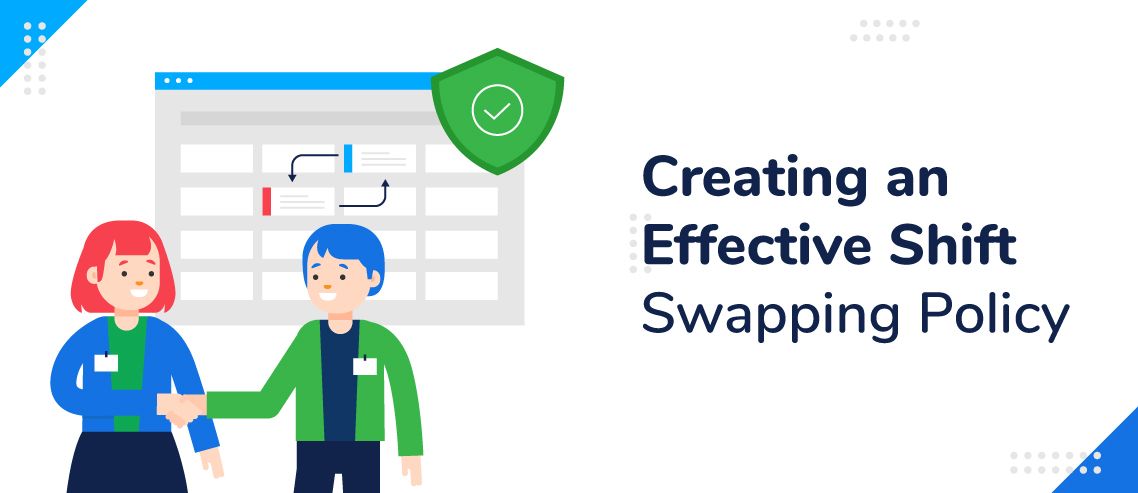How to Create An Effective Shift Swapping Policy

From time to time, your employees may end up needing to swap shifts. This is not an uncommon occurrence. But if you don’t have the right system in place, even a seemingly innocuous and routine procedure could end up causing a major headache for you.
Let’s say, for instance, you’re expecting Jody to show up for the Monday morning shift. But she swaps shifts with Steve without you knowing. Only, Jody is typically the one opening, and Steve doesn’t have a key to the store. He doesn’t know what the opening procedure is either and didn’t bother to ask, because he didn’t know it was going to be an issue.
If you usually show up a little later on a Monday, you might not have that luxury when Steve takes over Jody’s shift. You might get a call a little earlier than you were expecting.
The above scenario is a good reason to have an effective shift swapping policy.
Before we learn the process of setting up a shift swapping policy, let’s understand what a shift swapping policy is.
What is a shift swapping policy?
A shift swapping policy — a shift change policy and procedure — is a set of rules a company uses to trade employee shifts. As a shift swap policy example, if Jody and Steve are two employees who want to swap their shifts on a certain day and time, they would follow a strict set of protocols to avoid scheduling mistakes.
The benefits of having a shift swapping policy in place are many. First of all, it allows your employee’s freedom to be flexible in their schedules. However, the policy prevents confusion from happening when it comes to payroll or management duties. Too much flexibility could result in cutting corners if an exact policy is not outlined.
6 effective tips to set up shift swapping policy
1. Educate your employees
If your employees don’t know what your expectations are, they have no way of living up to them.
They should be introduced to your shift swapping policies as part of their training and onboarding.
If there is a formal process you require them to go through to swap shifts, they should be versed in it. If they need to notify anyone specific to request time off, they should be told who that is.
To ensure this information sticks with them, you may consider giving them an employee handbook or a simple handout that explains what they should be aware of with swapping.
2. Manager approval
Managers should always be aware of shift swaps. The reason is that your management team is your direct line of defense in holding up the company’s rules. Employees may very well swap their shifts with good intentions out of necessity.
However, without manager approval, it could cause a major issue with overtime, cross-training, or even assistant management duties. The manager’s approval also creates clear responsibility around who is required to show up at that shift time.
3. Share the schedule with your employees in advance
Sometimes, your employees will need to take time off on short notice. This isn’t ideal, but it is a reality many managers face.
If you share the schedule with your employees well in advance — preferably two to four weeks in advance. You will likely encounter fewer issues.
Your team members will be able to look ahead and see when they’re supposed to be coming in. Which can help them identify conflicts in their schedule ahead of time.
Then, you can ask them to notify you of any shift swaps they’re planning to make so you can adjust the schedule and nip issues in the bud.
4. Automate your process
Although the importance of shift swapping policy should not be underestimated, manual processes will only take you so far.
For instance, if you’re still passing around an Excel spreadsheet by email, you probably know by now that it’s challenging to maintain an up-to-date copy of the schedule. There’s a good chance you’re trying to compile multiple versions of the same document, which is a pain. Communication via email and SMS text can easily slip through the cracks too.
When you automate the process, it requires less of your time. You won’t need to babysit your employees. And you’ll keep your team members happier because they won’t have to get your approval for every swap.
An employee scheduling tool like ZoomShift can help you set up and maintain your employee schedule more effectively. The tool empowers you to set up shift swapping rules for your team members to use to swap shifts. With ZoomShift you’ll have a highly effective system that can run on near autopilot.
5. Keep the schedule predictable
For better or worse, employees tend to get used to working certain shifts over others and begin planning their lives around it.
If there are any sudden changes to the schedule, you might end up inviting conflict in the workplace. Even if certain team members have told you that they’re “flexible”, if their shifts suddenly change after three months of predictability, they might get upset because they’ve gotten used to the routine.
In an instance where you need to rotate day and night shifts, you need to communicate this ahead of time. As much as possible, mitigate any surprises that could catch your team off guard.
In addition, to keep the schedule predictable, talk to your employees and determine what their preferences are. You can get a good sense of when they’re willing and able to work, which can help you schedule your people at the right times.
6. Allow your employees to split shifts
Some of your team members may not need the entire day off. For instance, they may have a simple personal matter or errand to tend to that will not require them to be away for the full length of their six-hour shift.
If you allow your team members to split shifts, you can maintain a sense of consistency at the workplace.
In the above example, you could have one person working for three hours, and another covering the other three hours. You can ask the originally scheduled employee to prioritize whatever tasks need to be handled by them. So the person covering for them isn’t taken aback by what you might otherwise require them to do.
How to implement shift swapping with ZoomShift
ZoomShift is an all-in-one shift management software. It automates your shift swapping policy so your leadership team can focus on their true roles.
With ZoomShift’s “Shift Cover Request” feature, your employees and management team will always be on the same page. Here are just some of the advantages of “Shift Cover Request” (the shift swap feature):
- Keep morale high: Allow employees to cover for one another to work at the best time for them.
- Managers notified: managers get instant notification of shift swap requests. Irrespective of it’s been covered by any member or it’s yet to be assigned.
- Team alerts: When someone requests their shift to be covered, the entire team can see it instantly.
- Manager sign-off: Make sure your managers have the final say in approving shift covers, as per your shift swapping policy.
Your shift change policy and procedure should be systemized and automated. That way, you don’t risk paying overtime or mis-assigning an employee to a role they cannot perform. Luckily, ZoomShift allows you to enter several details for shift swaps — triggering a warning if the shift swap might trigger payroll or capability problems.
To manage your employees seamlessly get started with ZoomShift. It would help you streamline your shift scheduling, time tracking, paid time off and empower your employees to swap shifts on the go without any hassle.
JD enjoys teaching people how to use ZoomShift to save time spent on scheduling. He’s curious, likes learning new things everyday and playing the guitar (although it’s a work in progress).



